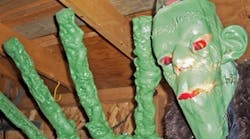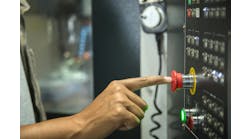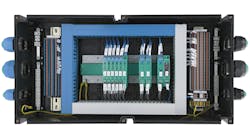Jim Montague is the executive editor for Control. Email him at [email protected].
About 15 years ago, one of my three daughters said we should set up a haunted house for Halloween. So we turned our old, one-car attached garage in Skokie, Illinois, into a simple haunted maze. It was made mostly out of black and semi-translucent plastic sheeting stapled over nylon kite string attached wall-to-wall to form chest-high partitions.
After a few years, we built a two-car, detached garage, and the Spooky Garage grew from five separate attractions or scenes to 10 or more. These include a falling battle axe; an eight-foot, newspaper-stuffed mummy that jumps up; a framed picture that drops out; a talking Frankenstein with glowing eyes and foam-insulation hands; and a circular saw that turns on by itself. Both the axe and the mummy are actuated manually via black clothesline strung along the ceiling, and my family, friends and simple wireless switches do the rest. Over the years, the Spooky Garage has become a neighborhood institution, averaging about 200 trick-or-treaters and their families annually.
Also Read: Consider the Need for Safety Switches
An internally lit, voice-activated Frankenstein figure with green-painted, foam- insulation hands is safetly secured to a wall in the Spooky Garage.
Because scaring people can be a bit risky—some moms jump back through the partitions—I also try to make the Spooky Garage as safe as possible. So even before covering machine safety, I noticed that I was unconsciously and organically performing what I've since come to recognize as basic risk assessments and human-factors engineering to protect my visitors, assistants and myself. I examine each situation we'll be in, evaluate the severity and frequency of each potential threat, design it out or mitigate it in some way, or repeatedly train and warn each participant about how to avoid it.
On the mitigation front, I realized early on that being startled puts people slightly off balance, so I never put them in situations where they have to step up or down or otherwise risk tripping. Second, I initially thought about making the battle axe out of plywood, but dropping it near someone's head could be dangerous, so I substituted light foam board covered with aluminum foil. Third, the mummy's booted feet are tied to his chair, so he can't swing out when he jumps up. Fourth, Frankenstein's arms are on hinges and can move towards visitors, but they're heavy and hard to control, so I've immobilized them, and had to be content with his eyes just lighting up and his voicebox growling "You cannot escape!" Fifth, the circular saw is tied securely to the wall and has the usual safety guard, but I also decided to take out the blade to remove any possible threat from it.
On the warning and training side, I require visitors to take off masks and hats, so they can orient themselves better. And I tell parents and taller kids to watch out and bend down to avoid the nylon strings. I've even tied plastic strips to the strings so they're easier to avoid. Volunteers behind the picture and in costume on a couch near the end also are trained not to get too close to the visitors to avoid the occasional panicked slap or fist.
So far, despite all the screams and people running out of the Spooky Garage, we haven't had any injuries—although some candy, little tiaras and foam ninja stars have been left behind. Anything could happen, of course, but I think continually considering each interaction in this mostly manual mechanism has allowed me to remove almost all potential difficulties and preserve the healthy thrills and chills. It's been helpful to be reminded that machine safety's best principles can be usefully employed in situations beyond the plant floor.





